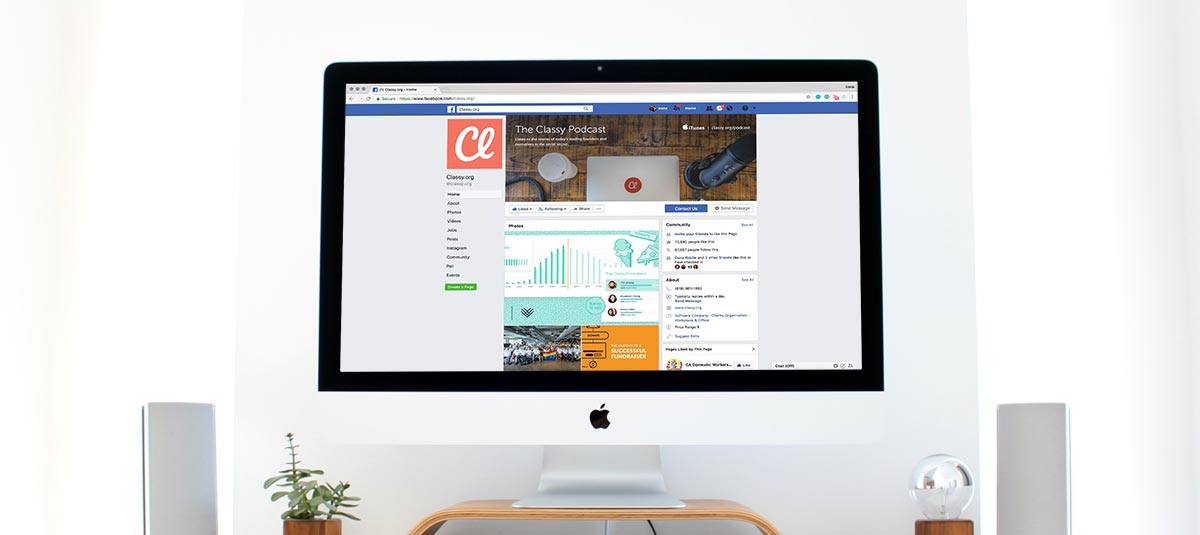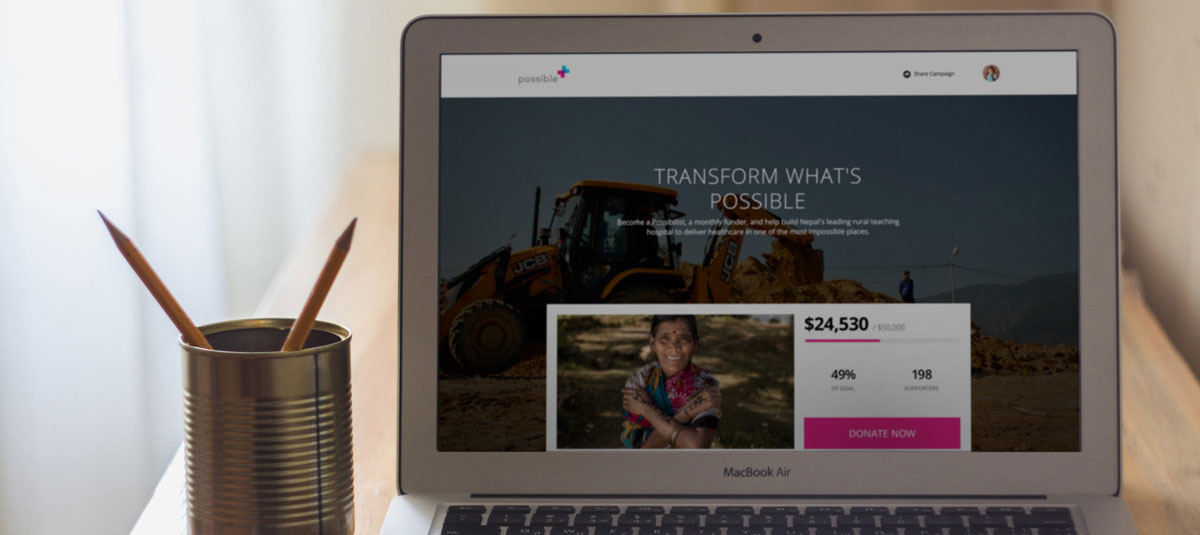How Should Facebook Play Into Your Fundraising Strategy?

Request a Demo
Learn how top nonprofits use Classy to power their fundraising.
As the ways in which nonprofits can use Facebook continue to morph, it can be challenging to understand how to balance the platform alongside your other tools.
While Facebook fundraising can be a great way to get eyes on your cause, there are some important limitations to consider before diving in. To understand the full picture, we reached out to our clients to give you a behind the scenes peek at what’s working, what’s not, and how they’re experimenting.
Below, we summarize our findings, as well as relay our conversation with Mark Hackett, the executive director at Operation Broken Silence, an organization building a global movement to empower the Sudanese people through innovative programs, who offers his firsthand perspective on the pros and cons of using Facebook and what it means to fold Facebook into your fundraising strategy.
In addition to everything Mark has to offer here, your nonprofit can take advantage of the Classy for Facebook integration. It allows you to seamlessly sync funds raised from Classy to your campaign while extending your mission to new audiences and empowering supporters to raise more money on your behalf.
Free Download: Classy + Facebook—A Guide to Boosting Fundraiser Retention
The Nonprofit’s Facebook Fundraising Experience in a Nutshell
Facebook fundraising can allow your nonprofit’s supporters to easily raise money on your behalf and spread your mission to their social circles directly on the channel. This is exciting given Facebook’s sheer number of users. After any initial transactions, however, today’s Facebook setup severely limits a nonprofit’s ability to communicate with any of those donors ever again.
To protect donors’ privacy, Facebook only shares the donor’s first and last name with the nonprofit, unless the donor opts into sharing their email. Unfortunately, only a very small percentage of donors opt in. This inhibits your nonprofit from being able to follow up with donors and retain these relationships. Today, subscribing to the nonprofit’s page isn’t part of the donation flow either, and there are no “custom groups” of donors you can communicate to directly through Facebook.
Some nonprofits create campaigns on their primary fundraising platform (like Classy) and share the link to their campaign on Facebook—or encourage fundraisers to share their personal fundraising pages on social media—which allows them to collect more supporter information and thus better engage and retain donors. Some nonprofits are launching native Facebook fundraising campaigns. Some are experimenting with a mixed strategy.
Executive Director Mark Hackett of Operation Broken Silence—an organization leveraging documentary films, photography exhibits, and events to mobilize people around the world—provides direct feedback about his nonprofit’s experience using Facebook fundraising and its opportunities and limitations below.
Understand if Facebook Fundraising Is for You
Before you dedicate resources to promote Facebook fundraising tools, it’s helpful to first determine the potential for engagement. Operation Broken Silence had two solid inquiries that led them to further explore the opportunity.
Ellie Burke: How did you discover that some of your audience prefer to fundraise through Facebook?
Mark Hackett: We had Classy in place since 2011 because we needed a platform that could not just accept donations and get people involved with fundraising, but also tell the Sudanese stories we highlight in a compelling way. We have used it for virtually all of our fundraising efforts. We do roughly 90 percent of our volume on Classy.
But recently we had a social media follower just start a fundraiser on their own through Facebook for our work shortly after we activated fundraising tools. That was quickly followed by another supporter deciding to fundraise via Facebook after we asked them to get more involved. Both individuals were long-time supporters of our work who decided to run a birthday campaign after receiving a notification from Facebook suggesting they fundraise leading up to their birthday. That is when we decided that we needed to include Facebook fundraising in our lineup of tools we offer to our movement members to maximize our donations.
Understand Facebook’s Strengths
Facebook’s fundraising tools allow nonprofit organizations to capitalize on the social media platform’s wide reach. In having the option to donate to your organization within Facebook, a donor can quickly contribute to your cause without being directed to another page.
EB: How do you currently leverage Facebook’s fundraising tools?
MH: We allow followers to start fundraisers through Facebook, leverage the Donate button on our profile page, and add Donate Buttons to posts.
Overall, we make it pretty clear that we very much prefer people fundraising on Classy because it gives them and us a lot more options and power than Facebook does; however, if someone is determined to fundraise on Facebook, we’re obviously not going to stop them. In these cases, we like to point them to the fundraising resources section of our website and provide helpful articles to help them be more successful on social.
We encourage people to share their Classy fundraising page on Facebook to reach a larger audience. And we also actively promote fundraising with Facebook’s tools on Facebook, but we do that pretty much just on Facebook. For example, we have a video about fundraising on Facebook pinned to the top of our page.
Additionally, we make use of a Facebook group we can share these opportunities to as well. That normally increases reshares on certain posts with Donate Buttons that resonate with our audience. This is especially useful since Facebook changed their algorithm early this year to emphasize friends and family posts in timelines over companies and organizations.
In the future, we also plan to include Donate buttons on live-streaming events we do from time to time. We haven’t tested this out yet, but we’re excited to see if it drives additional giving and engagement.
EB: What are some of the key benefits to leveraging Facebook?
MH: The main benefit seems to be that leveraging Facebook is a good “catch-all” for people who come across us on Facebook for the first time. Most of our new supporters discover us online because they see something one of their friends shared. Having a donation and fundraising option immediately available to people when they read one of our posts or visit our Facebook page for the first time communicates that they can help support our work in Sudan right then and there.
Another useful feature of Facebook fundraisers is the ability for a supporter to “invite” their friends to give. Most people are pretty tied to social media for a variety of reasons, and getting a notification inviting people to give to our work can lead to donations from people who are just learning about us for the first time.
Acknowledge Potential Drawbacks
Facebook undoubtedly allows your organization to cast a wide net and secure additional support, and many organizations, such as Susan G. Komen, have seen considerable success. However, there are still concerns and limitations to consider.
EB: What are the drawbacks to using Facebook?
MH: With Facebook, it has been much more difficult for us to get in touch with individuals who decide to fundraise or give. Less than 10 percent of individuals who have given to our work through Facebook have provided an email address, and less than 40 percent actually follow our Facebook page.
Plus, the delay between funds being raised on Facebook and being received by our organization is a big drawback. This is another reason why we greatly prefer Classy over Facebook. We empower Sudanese-led programs that exist in a warzone and a nearby refugee camp, so unexpected emergencies are fairly common. Having funds on hand to help our Sudanese partners mitigate problems that suddenly arise is a must in our line of work, so a delay in getting funds raised can be a setback.
The other big drawback is that it makes it a lot harder for our staff to empower individuals who decide to fundraise this way. A good number of our supporters are pleasantly surprised when they learn that we have a full-time staff member at their disposal to assist their efforts and a slew of fundraising resources designed by our past peer-to-peer fundraisers just like them. A supporter fundraising through Facebook may not be aware that we’re here to support them because it is difficult to contact them.
Somewhat related, we’ve stumbled into a few Facebook fundraisers an individual has started that we don’t see show up on the Fundraisers tab of our Facebook page. We assume this is because of the individual’s privacy settings. Because of this, we were unable to reach out to the individual and let them know we have some tips for them, as well as a full-time staffer that can help.
EB: How well are you able to collect donor information in order to follow up with new community members on Facebook? Are you seeing that donors provide enough information for you to follow up with them and get them into your cultivation funnel?
MH: As mentioned, less than 10 percent of individuals who have given to our work through Facebook have provided an email address, and only about half actually follow our Facebook page. By and large, donors via Facebook do not provide us enough information or options to begin cultivating a relationship.
With that said, we still use Facebook fundraising tools because we recognize there are a lot of people who like to give and fundraise for a lot of different causes. I think that audience is where Facebook fundraising tools are especially useful because it allows them to be engaged in a “one-and-done” kind of way. While our priority as an organization is cultivating our supporters and building them into a movement over the long-term, there is still value in having an individual give or fundraise one time and then move on to something else.
As Mark describes, Operation Broken Silence’s priority remains on cultivating supporters. Given that recurring donors are over four times more valuable than one-time donors, according to Classy’s report The State of Modern Philanthropy, Operation Broken Silence’s strategy is sound. They can leverage Facebook to make new connections, but when it comes to building relationships that last, they rely on Classy’s fundraising and engagement tools.
Connect Your Fundraising Worlds
It’s important to meet your supporters where they look to engage with your organization, and it’s important to build relationships that span the years so you can better serve your mission. As such, it can make sense to use Facebook in addition to your fundraising software.
EB: How, if at all, do you marry your efforts between the social platform and your Classy campaigns?
MH: Our Classy campaigns remain the central component of our movement building and fundraising focus. While Facebook’s fundraising tools are useful, they’re fairly minimal. With Classy, our supporters have a lot more tools and resources built into their fundraising experience that they can easily leverage, such as campaign videos on their fundraising pages, easier ways to invite people to give both online and offline to their goal, and easier access to our full-time staffer who empowers our fundraisers.
Because of these points, the vast majority of our social media posts, including those on Facebook, link people to our website or one of our Classy campaigns.
To connect your fundraising worlds and tools, you need to understand how the puzzle pieces fit together and how to use everything in concert. In this case, Facebook has the ability to act as a supplement for your existing fundraising goals. Acknowledge the purpose and potential of this tool to your larger team, and explain what, if any, resources you’re going to devote to this tool and why.
Let your team know that while there are significant barriers to cultivating and stewarding donors through Facebook, you may bring in “extra” revenue from one-time supporters you otherwise might not have encountered—which is beneficial.
But without ways to track donor data through Facebook, this tool can only be one small slice of your larger fundraising pie. Your fundraising software has the functionalities and integrations you need to attract, secure, track, and follow up with supporters. Once you’ve established your goals and expectations for your fundraising tools, you can map your overall plan out and identify any gaps and opportunities in your approach.
Fill the Gaps in Your Overall Fundraising Approach
Getting set up on Facebook allows your nonprofit to be discoverable on this platform. There’s no telling who might choose to fundraise for you through this far-reaching network—and that’s exciting! Being easily found on such a universal and grand scale is an invaluable tool to have in your fundraising arsenal.
However, as with any untested approach, it’s important not to plan to hit the fundraising lottery. What you can plan for is the rest of your strategy. How do you diversify your approach and protect your investments from potential risks? Consider the following initiatives to have in your toolbelt:
- Peer-to-peer fundraising campaigns
- A monthly giving program
- A year-round fundraising program
- Virtual fundraising event components
- Matching campaigns
- Integrated online and offline campaigns
And leverage all of these ways to safeguard your organization from what’s to come in your fundraising experience.
EB: What does a well-rounded fundraising strategy mean to Operation Broken Silence?
MH: Because of our mission and approach, a well-rounded fundraising strategy is everything. Our supporters come from a wide variety of backgrounds and experiences, so different components of our mission, brand, and communications resonate with some and not with others. Having a variety of fundraising and giving options readily available, and more importantly understanding which ones work best for different people, makes for a smoother experience for our supporters.
Simply put, without a well-rounded strategy, our Sudanese partners wouldn’t have the resources they need to move the needle, and we would be without purpose.
Check out Operation Broken Silence to learn more about their mission and programs.
To learn more about the Classy platform and how it can help you execute your overall fundraising strategy, connect with an expert below.

Design Your Movement
Subscribe to the Classy Blog
Get the latest fundraising tips, trends, and ideas in your inbox.
Thank you for subscribing
You signed up for emails from Classy
Request a Demo
Learn how top nonprofits use Classy to power their fundraising.
 Explore Classy.org
Explore Classy.org 

